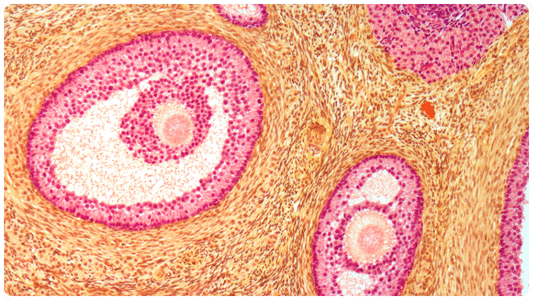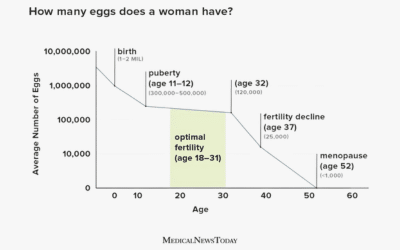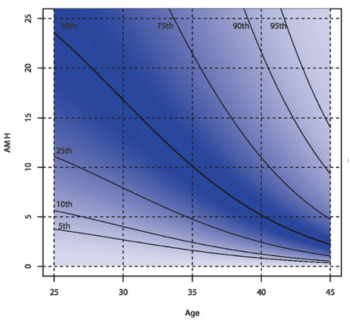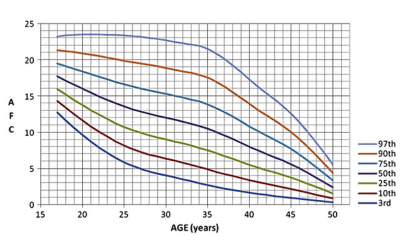
Updated on 17 December 2024.
Featuring Dr Devora Lieberman, NSW Medical Director and Sydney CBD fertility specialist.
For many people considering their fertility options, assessing ovarian reserve, or the quantity of remaining eggs, is an important step in making informed treatment decisions. Whether you’re having difficulty conceiving or want to consider egg freezing, knowing your ovarian reserve can guide decision-making.
What is ovarian reserve?

Source: https://www.medicalnewstoday.com/articles/how-many-eggs-does-a-woman-have#early-years
Women are born with all the eggs they will ever have, around 1-2 million. That number continues to decline until menopause.
Immature eggs are stored in fluid-filled sacs called follicles. In an ovulatory menstrual cycle, many follicles will start to grow. With the amount of follicle-stimulating hormone secreted by the pituitary gland in the brain, only one follicle will dominate and ovulate a mature egg. The rest of the follicles are reabsorbed by the ovary, never to be used again.
Ovarian reserve refers to the quantity of eggs that are stored in the ovaries and can give you an idea of how many eggs you might achieve in an IVF or egg-freezing cycle. Importantly, it’s not a measure of the quality of the eggs and cannot predict your chance of conceiving either naturally or with assisted conception.
What causes a low ovarian reserve?
There are many reasons why women may have a low ovarian reserve, including:
- Aging
- Cancer treatments like chemotherapy or radiation
- Genetic disorders
- Endometriosis
- Autoimmune disorders
- Losing one or both ovaries
How to test your ovarian reserve

Source: Fertility and Sterility, Vol95/Ed 2, Nelson SM et al., Nomogram for the decline in serum antimullerian hormone: A population study of 9,601 infertility patients, page 740, 2011, with permission from Elsevier
At City Fertility, we offer a range of fertility health check services to help you assess your fertility and understand the options that may be suited to you. There are two ways that we can look at your ovarian reserve:
There are two ways to determine egg reserve:
- Anti-Müllerian Hormone (AMH) level test
AMH is produced by the small follicles in the ovary that have not yet begun to develop. The level can be measured in a simple blood test that can be done at any time of the menstrual cycle. The AMH level reflects the number of eggs available in that cycle. AMH decreases in line with the age-related decline in follicle numbers.
How do AMH levels help to assess your egg reserve?
AMH is often promoted as an ‘egg timer’ test, an unfortunate misnomer. It doesn’t predict the age of menopause. AMH tells us where you sit relative to other individuals your age at a given point in time. So, a high level does not mean you’ll have no trouble conceiving in future, and a low level does not mean you will.
A low or high AMH for someone looking at freezing eggs or who is having difficulty conceiving will likely play a role in decision-making. If AMH is high, they may defer egg freezing or continue to try naturally. A high result may also indicate polycystic ovaries. Alternatively, if it’s low, they may decide to freeze eggs or move to IVF sooner, particularly if they would like more than one child. It may also suggest the for a need higher dose of medication to stimulate follicle growth in IVF or egg freezing. AMH is a reasonable predictor of the number of eggs anticipated in a stimulated cycle, which has implications for the chance of success.
-
Ultrasound imaging of the ovaries to evaluate the antral follicle count (AFC).

Source: https://www.semanticscholar.org/paper/Age-related-normogram-for-antral-follicle-count%3A-Almog-Shehata/3d1295742865add6249276c7d488459245f66d43/figure/0
The AFC assessment involves a transvaginal ultrasound examination typically conducted on days five to nine of the menstrual cycle. During this procedure, ultrasound imaging is used to assess the total number of follicles present in both ovaries.
It bears repeating that although AMH and AFC are markers of egg quantity, they do not reflect oocyte quality or predict the chance of conception or of having a live birth. As of yet, there are no biomarkers of egg quality.
The role of ovarian reserve testing
This assessment can provide insights into your reproductive potential in IVF or egg freezing and guide your decisions on family planning and fertility treatments. Some of the key roles that ovarian reserve testing plays in your fertility journey:
- Fertility Counselling: Assessing ovarian reserve can also be an essential component of fertility counselling. Your fertility specialist will often order an AMH test as a first step on your journey. They can use this information to understand your unique situation better and explore your options.
- Fertility Treatment Planning: Knowing your AMH and AFC levels can guide your treatment plan if you decide to proceed with fertility treatment. It helps optimise medication dosages and predict the likelihood of a successful response to ovarian stimulation.
- Egg Freezing: If you’re considering freezing your eggs for future use, knowing your ovarian reserve can help determine the number of eggs that can be retrieved and preserved. This information ensures that you have a realistic expectation of the outcome.
Next steps
Assessing your ovarian reserve through AMH and AFC tests is a valuable step in your fertility journey. While these tests provide insights into egg quantity and your potential response to treatment, it is essential to note they do not reveal information about egg quality or guarantee success.
Remember that fertility can be complex and multifaceted, and while assessing ovarian reserve is important, it’s only one part. Discussing the results of these tests with your fertility specialist and developing a personalised fertility plan that aligns with your goals and expectations helps to put the rest of the puzzle pieces together.
To book an appointment or learn more about Dr Devora Lieberman, visit her profile.
Ovarian Reserve FAQs
How many ovaries do women have?
Women have two ovaries, one on either side of the uterus. Ovaries are small oval-shaped glands that produce eggs and secrete the estrogen and progesterone hormones.
What is an egg follicle?
Ovarian or egg follicles are small fluid sacs that typically carry one egg each during each monthly menstruation cycle. The follicles secrete the hormones that influence the cycle stages and guide puberty.
How many eggs does a woman have?
Females are born with one- to two-millions eggs, but as they age the number diminishes. Of these, only 400 000 to 500 000 are still viable at puberty. Up until menopause, a woman ovulates (releases eggs) about 400 to 440 times.
What are signs of poor egg quality?
Difficulty conceiving, recurrent miscarriage and irregular period cycles can all be signs of a low egg count. If you’re over the age of 35, it might be time to investigate your ovarian reserve further.
How can I improve my egg quality?
There are a few things you can do to improve your egg quality, including:
- Maintaining a healthy weight
- Exercising and eating well
- Reducing smoking, caffeine and alcohol intake
- Reducing stress
- Consider taking pre-pregnancy vitamin supplements such as folic acid















